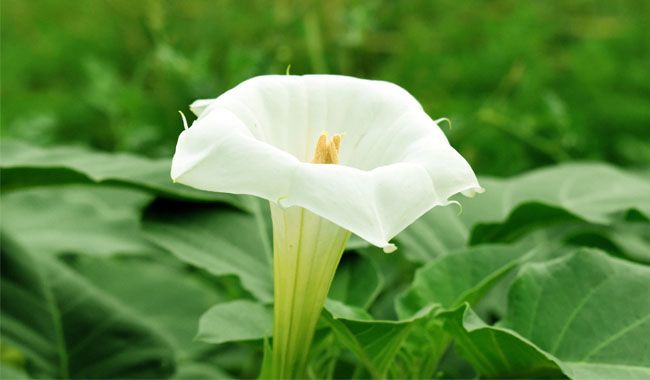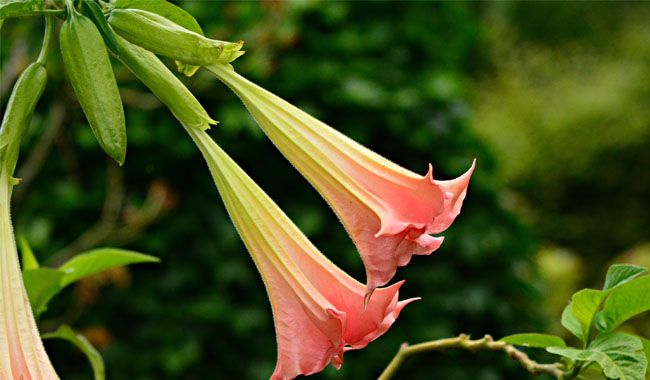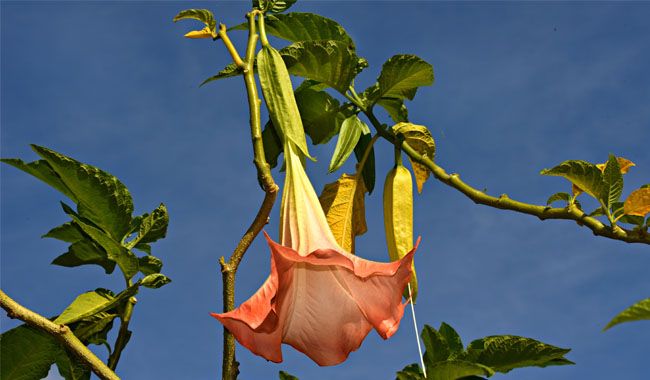
The huge bell-shaped flowers are mesmerizing, but Brugmansia (Angels Trumpet) is still a winter intolerant garden plant. When deciding to grow this giant plant with its fragrant fragrance and fruity color as a houseplant, it is important to evaluate your chances. Wherever Brugmansia can overwinter, it is not easy to grow and requires lots of fresh air and exceptionally bright light. Anywhere will not do. When growing Brugmansia in a room, the key to success is choosing a suitable spacious location and being outside in the summer. Failure to meet these two conditions cannot correct a blunder, even with the most careful care. In this article you will learn how to grow Brugmansia Plant and how to take care of it.
WHICH BRUGMANSIA (ANGELS TRUMPET) CAN BE GROWN INDOORS?
Brugmansia (Angels Trumpet), the indoor and boxed Angel’s Trumpet, are mostly hybrids. Brugmansia suaveolens, Brugmansia Arborea, Brugmansia Versicolor, and Brugmansia candida impresses their huge, up to 10 inches (25 cm) or larger, tubular, pendulous flowers that bloom by the hundreds in their lush, cloud-like canopies in midsummer.
These varieties are distinguished only by the color of their flowers – white, yellow, pink, or fruity – and the intensity of their fragrance. On the other hand, in terms of cultivation, they are identical to the typical poisonous Solanaceae.
WHERE TO PUT BRUGMANSIA (ANGELS TRUMPET) INDOORS?
Even in its compact form, Brugmansia is still a real giant. It is best always to remember that this is a huge flower that needs to develop evenly. At any age, Brugmansia should be placed where it is not leaning on anything, and its branches are allowed to develop freely. Air should flow easily around the plant from all sides.
Special site requirements for Brugmansia include the need to move to fresh air throughout the warm period. If not placed on a balcony, terrace, garden, or greenhouse, additional lighting with plant lights will only be successful if done regularly.
DORMANCY OF BRUGMANSIA (ANGELS TRUMPET)
In a mild and cool environment with minimal watering, a nutrient-free phase should last from October to February. The lighting during this period determines only whether the plant retains its leaves or drops them (usually with some twigs). At the end of February, more aggressive watering should begin immediately to return Brugmansia to conditions similar to an active growth period.
WHAT DOES BRUGMANSIA (ANGELS TRUMPET) NEED FOR FLOWERING IN A ROOM?
- contrasting daytime and nighttime temperatures suitable for germination – up to 50-59 °F (10-15 °C)
- maximum light, similar to a controlled greenhouse or outdoors.
- plenty of fresh air.
- Regular nutritional supplementation.
TEMPERATURE OF BRUGMANSIA (ANGELS TRUMPET)
The plant is particularly active when the temperature exceeds 77 °F (25 °C). However, the plant is best kept outdoors only on all days when the temperature is above 50 °F (15 °C). In rooms, the temperature range during active vegetation, even on south-facing windows, is best left between 64-77 °F (18-25 °C).
Overwintering is the most difficult part of Brugmansia flower cultivation. Even in subtropical latitudes, where plants lose their above-ground parts while growing in the ground, the minimum temperature for Brugmansia is 41 °F (5 °C) and the optimum temperature is 50-59 °F (10-15 °C). Greenhouses, greenhouses, and basement places should be chosen as close to the ideal temperature as possible.
LIGHTING FOR BRUGMANSIA (ANGELS TRUMPET)
Even in the garden, Brugmansia prefers to grow in a sunny, open area. In contrast, it is tough to provide them with sufficient light during the flowering period in a room. They are not afraid of direct sunlight at all and even need it. With a slight lack of light, they cannot flower or develop properly. Ideally, Brugmansia should be kept in bright outdoor light for as long as possible. To grow Brugmansia, you should choose the brightest part of the house, the southern, westernmost windowsill.
If the plant is not suitable for the window, it should be placed as close to the window as possible. And the probability of not having enough light in the room to bloom remains high, so adding light with plant lights is almost always a must.
For resting Brugmansia, the foliage is sacrificed and, as a last resort, can be kept in the dark. Only additional light can be used after moving the plant into the room to prolong the blooming time in autumn. It is also the perfect “helper” at the end of the dormant period. Once the plant is back in a warm place at the end of February, it should be given at least 1-2 weeks of extra light to start active and even growth.
POTS AND SUBSTRATE FOR PLANTING BRUGMANSIA (ANGELS TRUMPET)
Only young plants can be grown in classic pots. As it ages, Brugmansia grows large, and the size of the root system usually requires pots. The proportions should remain classic and require deep containers with large drainage holes.
It is a pot that needs fertile soil. A humus-drained, coarse substrate based on turf soil is only suitable for Brugmansia if it has a neutral or slightly acidic pH (5.5-7.0.) It is best to choose potting soil for azaleas or hydrangeas. If you mix your substrate, half of the sand, peat and humus (or compost) should be added to the turf soil.
WHEN AND HOW SHOULD I TRANSPLANT BRUGMANSIA (ANGELS TRUMPET)?

Replace the container only when the plant has completely absorbed the previous one. If no roots have appeared in the drainage holes and on the surface, then Brugmansia should not be transplanted yet. If there are signs of overgrowth, next March/April is the right time.
Plants are transplanted annually only in the first years; on average, adult Brugmansia is transplanted every 3-5 years.
The most important rule for transplanting is to do it with the root ball in place. A very high drainage device should be placed at the bottom of the container. Carefully remove the plant, turn the pot upside down, tap on the walls, touch the roots as little as possible, hold it in place with the base of the stem. And set in the soil at the same level as before. Water immediately after transplanting, place in a semi-mountainous area with mild temperatures and do not fertilize for 1.5 months – all of which Brugmansia (Angels Trumpet) needs to get used to.
When the maximum capacity of the pot is reached, replace the topsoil only every 4-6 months.
HOW SHOULD I WATER MY BRUGMANSIA (ANGELS TRUMPET)?
Only a stable average soil moisture level will allow Brugmansia to develop and flower properly. Mature trees, especially once outside the garden, need to be watered frequently (up to 2 times a day, in the morning and the evening). It is best to let the soil dry to a maximum of 1-2 inches (2.5-5 cm) throughout the warm period. Standing water is destructive to plants, and rot can quickly affect the root system. Trays should be emptied immediately.
During the resting period, watering should be reduced. If Brugmansia is overwintered in a well-lit place, keep the soil slightly moist. If in the dark – reduce watering to a minimum (1 time per month).
THE HUMIDITY OF BRUGMANSIA (ANGELS TRUMPET)
It is a tropical, humidity-loving plant that does not adapt to all conditions. The higher the humidity of the air, the more active Brugmansia grows, the more it blooms, and the less it gets sick. The ideal is a humidity level of around 60%. Below 50%, it should not drop. Otherwise, the quantity (and quality) of flowers will suffer. A tray with moist moss or clay pebbles is ideal. However, spraying can also be used. Despite the light-colored pubescence of the leaves, Brugmansia is not at all afraid of moisture. Only the flowers do not want to get wet.
FERTILIZERS AND FERTILIZERS SUITABLE FOR BRUGMANSIA (ANGELS TRUMPET)
Fertilize Brugmansia only in spring and summer when there is foliage and active growth. The best course of action is the same as for regular garden stars – apply the fertilizer weekly at the standard dosage recommended by the manufacturer, along with the water for watering. If growth problems occur, stop fertilizing, and if the plant has not been transplanted for more than 2 years, you can increase the frequency to 2 applications per week in the summer. Do not fertilize in winter.
Fertilizers for beautiful flowering plants are best suited for Brugmansia. Nitrogen is more important in the early stages of growth and can be used as a basic all-purpose fertilizer or as a nitrogen fertilizer in the spring.

PRUNING AND SHAPING BRUGMANSIA (ANGELS TRUMPET)
This plant is shaped in autumn, before the dormant period, as needed. Since Brugmansia can easily exceed 10 feet (3 meters) in height and can become too large if left unchecked, it is best to shape and control the height of the bush from the first year. Don’t worry about flowering; this plant flowers on its shoots.
In the beginning, it is best to remove thin, dry, and damaged shoots, assess the crown, and shorten the branches as intuitively as possible to make them neatly shaped – by a few inches, a third or up to ⅔ of their length (most importantly, leave at least 2 or 3 buds). On young plants, the shape of the bush can be achieved by simply pinching off the tips.
For Brugmansia, remove the wilted bell-shaped flowers by hand and do not let them stay on the plant for too long.
PROBLEMS IN GROWING BRUGMANSIA (ANGELS TRUMPET)
The pests and diseases of Brugmansia are as follows.
- Spider mites.
- Whiteflies.
- root rot and stem rot.
Lack of light is the key to most problems with this plant. In particular, it is the lack of light that leads to poor or no flowering and causes the leaves to fall off.
The signs of improper watering, overwatering, or lack of moisture are strikingly similar in Brugmansia. If you make some mistakes on the plant, the leaves will become spotted and yellow. To understand the cause, the condition of the substrate and root system must be checked.







